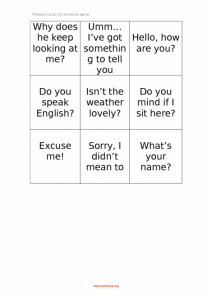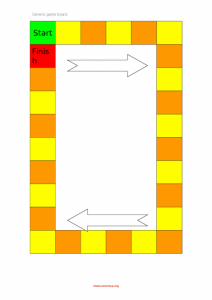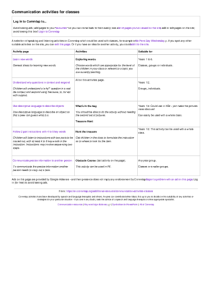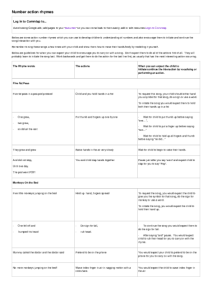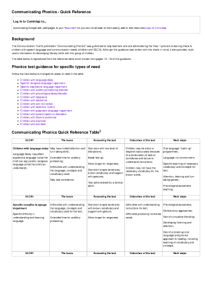Search
User login
Topic “Primary (5-11yrs)”
Primary school age (5-11 years)
Phrases cards for emotions game
Created 18 October 2012; updated 30 April 2022.
Generic game track
A coloured track which, along with dice and counters for example, could be used to make a variety of activities into a game - for example, shake the dice, move the counter, and if you land on an orange square, pick a card and describe what is on it.
Created 18 October 2012; updated 19 July 2015.
1-6 Grid
Grid containing the numbers 1 to 6. This can be used in a number of games - for example this emotions game.
Created 18 October 2012; updated 30 April 2022.
Sources of Information, Support and Additional Resources
This is a list of some sources of information, support and resources in the UK. You can edit this page, or you could create another page for organisations in your country.
Information and Support
Sources of Information, Support and Additional Resources
Created 10 October 2012; updated 2 August 2025.
Communication activities for classes
Created 12 September 2012; updated 11 May 2023.
Communication activities for classes
A selection of speaking and listening activities on Commtap which could be used with classes, for example on No Pens Day Wednesday. If you spot any other suitable activities on the site, you can edit this page. Or if you have an idea for another activity, you could add it to the site.
Understand and use ordinals (1st, 2nd, 3rd etc)
| Activity/strategy name and materials required | How to do the activity | Key principles for doing the activity and comments |
|---|---|---|
| Write it Writing materials |
| This works best 1:1. Use this activity only with a child who can read and write. With children with less good literacy skills, you will need to talk about what you are going to focus on, but miss out the written support. With children who can cope with larger numbers, you might want to go beyond 10, be careful to explain how numbers such as 21st, 22nd and 23rd are formed. |
| Line up None | This works best with a class or group. You may want to focus more on the front of the line. | |
| PE Equipment as required by the PE activity | This works best with a class. | |
| Small World Small world equipment, including several ‘people’. | This works best 1:1. This activity is more suited to younger children. | |
| Actions Equipment as required by the actions. Visual prompt cards if required. | This works best 1:1 or with a small group. Make sure you stress words such as “first”, “second” etc. Bear in mind the child’s auditory memory – the more instructions you give, the harder it will be to remember them. |
Learn new words
| Activity/strategy name and materials required | How to do the activity | Key principles for doing the activity and comments |
|---|---|---|
| Exploring words Written word with a picture Written sounds for beginning/ end of each word Visuals for the story Dictionary (maybe)
| Ideas you can use to help word learning - you do not need to use all of them, and some will work better than others for different children. 1. Introduce the written form of the word; 2. Say the word to the child and ask for repetition; 3. Ask the child to clap syllables on your or their hands, use prompting if necessary. Or alternatively they could tap the syllables out on pictures of drums (say four arranged in a row); 4. Ask if any other words rhyme with this new word (think of examples yourself) - you could take this in turns in a group; 5. Ask for beginning and ending sounds; 6. Tell the child a short story or anecdote, including the word as the main feature if possible - or work with the child to work a story out; 7. Give an explicit definition (school dictionary maybe - some dictionaries are more helpful than others for this!) and give context(s) preferably first one being the one used in the story as it’s familiar but make sure to offer other contexts; 8. Ask the child if they can put the word in a sentence/ tell a short story including the word; 9. If ability allows, ask the child if they know of any word which means a similar thing. | These activities help to build a child’s vocabulary with solid representations of words. It gives a child strategies to use when learning and remembering new words. It builds the child’s confidence on a topic, especially if taught before the relevant lesson. |
Number action rhymes
Below are some action number rhymes which you can use to develop children’s understanding of numbers and also encourage them to initiate and continue the song/interaction with you.
Remember to sing these songs a few times with your child and show them how to move their hands/body by modelling it yourself.
Communicating Phonics - Quick Reference
Created 13 June 2012; updated 6 December 2024.
Communicating Phonics - Quick Reference
Background
The Communication Trust's publication "Communicating Phonics" was published to help teachers who are administering the Year 1 phonics screening check to children with speech language and communication needs (children with SLCN). Although this guidance was written with this check in mind, it also provides much useful information for developing literacy skills with this group of children.
The table below is reproduced from the reference table which comes from pages 12 - 16 of this guidance.
Initiate a request for items to do a task
| Activity/strategy name and materials required | How to do the activity | Key principles for doing the activity and comments |
|---|---|---|
| Impossible task! Materials as needed, for example:
| Ask the child to carry out tasks without giving them the equipment they need. For example:
| If a child does not request anything, you can try to motivate the child to correct you or "help you", for example:
See also suggestions here: make a choice at snack time |
Support Commtap to keep it online
Thank you for visiting Commtap.
Please read this message as it is extremely important.
- Visitor donations mean we can continue to host over 1,000 free activities to support speech, language, and communication development.
- Visitor donations mean we can continue to provide free resources to address a wide range of communication needs, including limited speech or language, interaction challenges, and needs associated with conditions such as developmental language disorder, autism, and cerebral palsy.
- Visitor donations mean we can continue to provide resources to support the work of speech and language therapists, teachers, teaching assistants, parents, and carers.
- Visitor donations mean we can continue to provide the free key word sign dictionary (bks.org.uk) which has over 2,000 Makaton and Signalong signs.
We know that not everyone is able to afford to pay to access these resources, however, if you can, please make a donation to keep the site going.
Thank you
Google ads on this page are provided by Google Adsense - and their presence does not imply any endorsement by Commtap. Report a problem with an ad on this page. Log in (for free) to avoid seeing Google ads.

